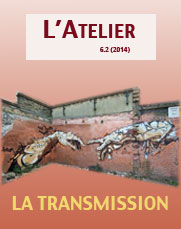Passing on the Prometheus Myth: Shelley's Misreading of the Setting of Prometheus Bound
Mots-clés :
Shelley, Percy Bysshe, Poésie romantique, Prometheus Unbound, setting, transtextualityRésumé
The literary myth of Prometheus which Percy Bysshe Shelley (1792-1822) seeks to transmit in “Prometheus Unbound” (1818-20) is constituted of several motifs, among which its setting as suggested by Aeschylus in Prometheus Bound (Vth century B.C.). This article shows how Shelley's expansion of the Aeschylean landscape transcends literary opportunism or the anxiety of influence, to flesh out Scythia, Caucasus, which the Athenian actually barely describes, and Asia's vale, which the poet adds to the Promethean diegesis. To do so, the poet draws on the Swiss Alps and Italy, as critics have already noted, but this paper also shows that it affects the symbolism of the “lyrical drama”. Indeed, the Shelleyan setting can be described as polarized between the corrupt Caucasian West and the ideal or regenerating “Italian” East.
This transtextual study borrows Gérard Genette's terminology in Palimpsestes (1982) to interpret the transformations of the main hypotext, Prometheus Bound, which is contaminated by others, namely Shelley's letters. Even before composing “Prometheus Unbound”, the poet in fact projects his own vision of “Promethean mountains” onto Aeschylus's setting, thus constituting an intermediary text influenced by the ancient's suggestions, other literary influences and the poet's direct experiences of the Alps and divine climate of Italy. Ultimately, rewriting his epistolary descriptions enables Shelley to recollect beautiful and sublime scenes in tranquillity.
Le mythe littéraire que Percy Bysshe Shelley (1792-1822) cherche à transmettre dans “Prometheus Unbound” (1818-20) est constitué de plusieurs motifs, dont son décor tel qu'il est évoqué dans le Prométhée enchaîné d'Eschyle (Ve siècle av. J.-C.). Cet article montre comment l'expansion de ce décor transcende l'opportunisme littéraire ou l'angoisse de l'influence pour donner forme à la Scythie, au Caucase, qu'Eschyle décrit en fait à peine, et la vallée d'Asie, que Shelley rajoute à la diégèse prométhéenne. Pour ce faire, Shelley puise dans les Alpes suisses et l'Italie, ainsi que certains critiques l'ont déjà montré, mais cet article se propose également d'en étudier l'impact sur le symbolisme de la “pièce lyrique”. En effet, le décor shelleyen apparaît comme polarisé entre deux extrêmes, l'Occident caucasien corrompu et l'Orient “italien” idéal ou en cours de régénération.
Cette étude transtextuelle emprunte à Gérard Genette (Palimpsestes, 1982) sa terminologie pour interpréter les transformations de l'hypotexte centreur, Prométhée enchaîné, qui est contaminé par d'autres sources encore, principalement les lettres de Shelley. Le poète projette en fait sa propre vision des “montagnes prométhéennes” sur le décor d'Eschyle et ce bien avant la composition de “Prometheus Unbound”. Il existe donc un hypertexte intermédiaire, constitué des suggestions d'Eschyle, d'autres influences littéraires et de l'expérience directe des Alpes et du climat “divin” de l'Italie. Au bout du compte réécrire ses descriptions épistolaires permet aussi à Shelley de se remémorer en toute quiétude des scènes belles et sublimes.Publiée
Numéro
Rubrique
Licence
-
L’envoi spontané d’un article à la rédaction de L’Atelier implique l’autorisation de publication et la cession des droits dans les limites établies par la loi de propriété intellectuelle.
-
L’Atelier conserve les droits de reproduction des articles publiés, quelque soit le support : internet, CD ROM, réimpression, photocopie, etc.
-
L’auteur conserve le droit de publier ultérieurement son article déjà paru dans L’Atelier avec la seule obligation de mentionner le nom de la revue comme source de la première publication.


